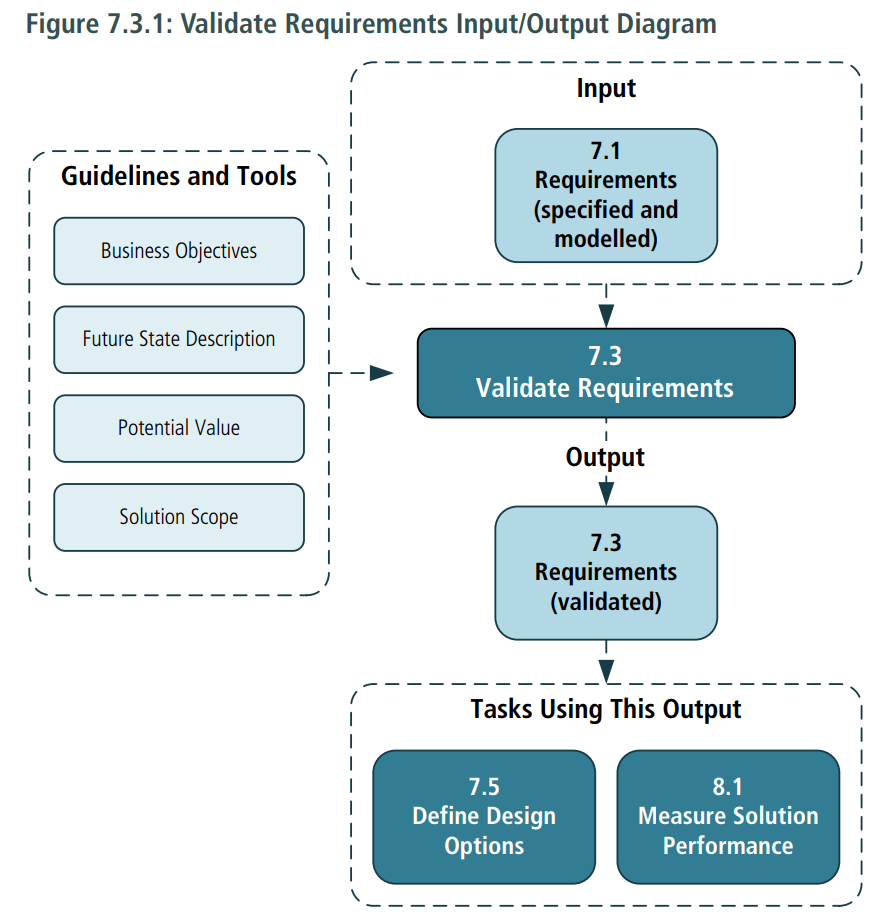7.3.1 Purpose
The purpose of Validate Requirements is to ensure that all requirements and designs align to the business requirements and support the delivery of needed value.
7.3.2 Description
Requirements validation is an ongoing process to ensure that stakeholder, solution, and transition requirements align to the business requirements and that the designs satisfy the requirements.
Understanding what the desired future state looks like for stakeholders after their needs have been met is valuable to business analysts when validating requirements. The overall goal of implementing the requirements is to achieve the stakeholders’ desired future state. In many cases, stakeholders have different, conflicting needs and expectations that may be exposed through the validation process.
7.3.3 Inputs
- Requirements (specified and modelled): any types of requirements and designs can be validated. Validation activities may begin before requirements are completely verified. However, validation activities cannot be completed before requirements are completely verified.

7.3.4 Elements
.1 Identify Assumptions
If an organization is launching an unprecedented product or service, it may be necessary to make assumptions about customer or stakeholder response, as there are no similar previous experiences on which to rely. In other cases, it may be difficult or impossible to prove that a particular problem derives from an identified root cause. Stakeholders may have assumed that certain benefits will result from the implementation of a requirement. These assumptions are identified and defined so that associated risks can be managed.
.2 Define Measurable Evaluation Criteria
While the expected benefits are defined as part of the future state, the specific measurement criteria and evaluation process may not have been included.
Business analysts define the evaluation criteria that will be used to evaluate how successful the change has been after the solution is implemented. Baseline metrics might be established based on the current state. Target metrics can be developed to reflect the achievement of the business objectives or some other measurement of success.
.3 Evaluate Alignment with Solution Scope
A requirement can be of benefit to a stakeholder and still not be a desirable part of a solution. A requirement that does not deliver benefit to a stakeholder is a strong candidate for elimination. When requirements do not align, either the future state must be re-evaluated and the solution scope changed, or the requirement removed from the solution scope.
If a design cannot be validated to support a requirement, there might be a missing or misunderstood requirement, or the design must change.
7.3.5 Guidelines and Tools
- Business Objectives: ensure the requirements deliver the desired business benefits.
- Future State Description: helps to ensure the requirements that are part of the solution scope do help achieve the desired future state.
- Potential Value: can be used as a benchmark against which the value delivered by requirements can be assessed.
- Solution Scope: ensures the requirements that provide benefit are within the scope of the desired solution.
7.3.6 Techniques
- Acceptance and Evaluation Criteria: used to define the quality metrics that must be met to achieve acceptance by a stakeholder.
- Document Analysis: used to identify previously documented business needs in order to validate requirements.
- Financial Analysis: used to define the financial benefits associated with requirements.
- Item Tracking: used to ensure that any problems or issues identified during validation are managed and resolved.
- Metrics and Key Performance Indicators (KPIs): used to select appropriate performance measures for a solution, solution component, or requirement.
- Reviews: used to confirm whether or not the stakeholder agrees that their needs are met.
- Risk Analysis and Management: used to identify possible scenarios that would alter the benefit delivered by a requirement.
7.3.7 Stakeholders
- All stakeholders: the business analyst, in conjunction with the customer, end users, and sponsors, has the primary responsibility for determining whether or not requirements are validated. Other stakeholders may discover problematic requirements during requirements communication. Therefore, virtually all project stakeholders are involved in this task.
7.3.8 Outputs
- Requirements (validated): validated requirements and designs are those that can be demonstrated to deliver benefit to stakeholders and align with the business goals and objectives of the change. If a requirement or design cannot be validated, it either does not benefit the organization, does not fall within the solution scope, or both.
